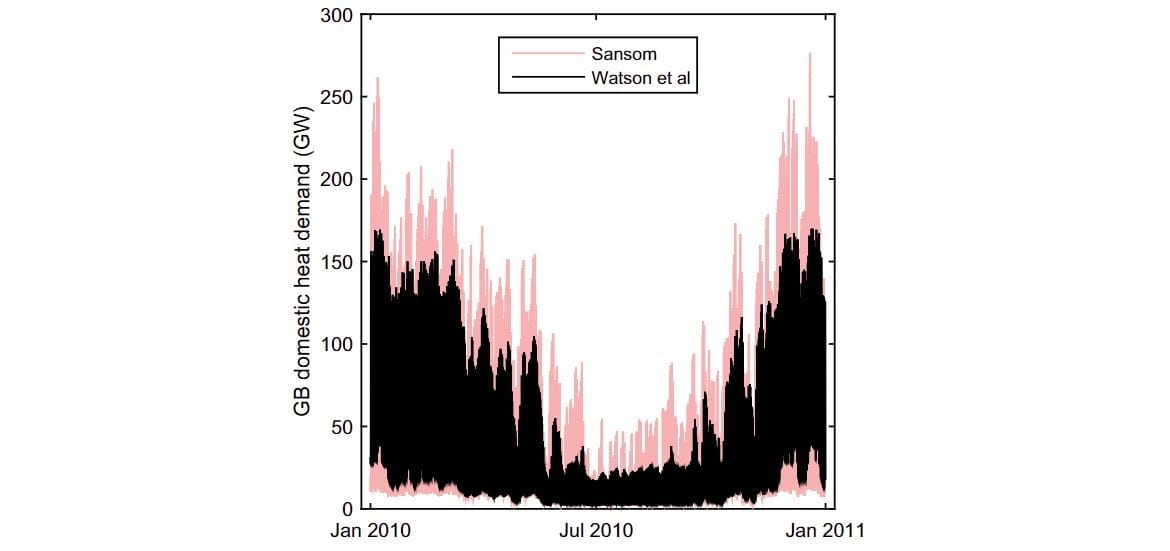In 2018 the National Grid projected 12m heat pumps by 2041 in its Future Energy Scenarios projection, whilst the Committee on Climate Change’s Fourth Carbon Budget is calling for 2.5m heat pumps by 2030 and the end of all gas boiler installations by 2035.
This ambition and forecast UK growth for heat pumps supports environmental and societal drivers for low-carbon and low-cost heating, yet has been met with some concerns about the impact electrically powered heat pumps could have on the electricity grid.
A new paper examining the impact of large scale deployment of heat pumps on national demand and peak demand has been published in the international peer-reviewed journal, Energy Policy, in which it is concluded that the electrification of domestic heating on the grid is far less problematic than previously thought, affirming the long-term prospects for heat pumps.
The report, Decarbonising domestic heating: What is the peak GB demand?, states:
The calculated peak domestic heat demand of 170 GW is around 40% lower than previously calculated suggesting that the difficulties surrounding the electrification of heat are far less profound than previously assumed. These results can be used in the development of future energy pathways and scenarios.
Highlights of the report:
- GB half-hourly domestic heat demand was estimated from monitored data.
- Peak heat demand is 170 GW, around 40% lower than previously thought.
- Maximum ramp rate is 60 GW/h, around 50% lower than previously thought.
- Electrification of domestic heating therefore less problematic than assumed.
The paper challenges previous findings, concluding:
The peak demand and maximum ramp rate are respectively 40% and 50% less than the values produced by Sansom, which have been widely used for informing future GB and UK domestic heating scenarios.
The model’s predictions, together with considerations of the way in which the housing stock will evolve, changes to heating technology, and changes in the UK demographic, could have far-reaching implications. In particular, the work here suggest that peak heat demand and maximum ramp rate have been very substantially overestimated, leading to overly pessimistic assessments of the prospects for electric heating (e.g. Howard and Bengherbi, 2016). A shift towards heating GB’s homes using electricity, rather than natural gas, will therefore put much less pressure on the electricity supply system than previously anticipated. Nevertheless, the electrification of heating remains a significant challenge, and is likely to result in considerably greater peaks in electricity demand and seasonal variation than at present.
A recent UK government policy document on decarbonisation (BEIS, 2017a) states that it is uncertain which combination of low-carbon heating technologies will work best at scale. The development of more accurate estimates of half-hourly domestic heat demand is a key step in determining a cost-effective solution for decarbonising UK domestic heat demand and clarifying this uncertainty. The model presented here offers this greater accuracy.
The report can be read in full here: https://www.sciencedirect.com/science/article/pii/S0301421518307249
Kensa’s Contracting Director, Dr. Matthew Trewhella, comments on the reports findings:
This report increases confidence that the UK can meet it’s carbon reduction targets via the electrification of heat through the use of ground source heat pumps. Unlike direct electric, heat pumps produce more heat than the electric that they consume which will reduce the load imposed on the grid. When using ground source heat pumps, this strain is further reduced because ground source heat pumps are typically 20-25% more efficient than air source heat pumps.
Furthermore, the ground is a very stable temperature heat source allowing you to run the heat pump at the same efficiency any time of day or night (unlike air source where the efficiency is lower when the outside air temperature is lower at night). If you combine this feature with some energy storage local to the heat pump, it would be possible to even further reduce the peak demand by shifting heat production to times when the grid can best accommodate it. This will have a dramatic improvement on the amount of further generating capacity required to meet demand and will facilitate the use of more intermittent generation (e.g. wind power) and steady state generation (e.g. nuclear).
The paper ends by cautioning us not to underestimate the challenge but this modelling helps to make that challenge more attainable.
Kensa are working hard to develop integrated systems that control heat production and storage that will have the triple effect of helping to balance the grid, lowering heating costs for householders whilst maintaining comfortably heated properties.


Source: Decarbonising domestic heating: What is the peak GB demand? Fig.10. Synthesised GB Domestic heat demand in 2010, according to Sansom and according to the results produced here.
The report coincides and supports findings in the Greater London Authority (GLA) report, ‘Low Carbon Heat: Heat Pumps In London’ (read Kensa’s in-depth review of the GLA report here). One of the key observations in the ‘Low Carbon Heat: Heat Pumps In London’ report was that ‘demand for electricity in the most ambitious heat pump deployment scenario decreases’. The authors, Etude Consulting, state in the report:
The impact of heat pumps on the electricity grid is sometimes quoted as one of the barriers to a greater uptake of heat pumps in London. While the use of heat pumps increases demand for electricity for heating, overall demand for electricity in the most ambitious heat pump deployment scenario actually decreases as a result of improved energy efficiency in other sectors and extensive use of energy storage technologies, driven by time of use tariffs.
Kensa says:
Heat pumps should be viewed as part of the solution to balancing demand on the grid, rather than adding to the problem.
By electrifying the grid via ground source heat pumps, your overall investment in electrical generation goes down. Once we get to scale deployment of heat pumps, they will offer even greater grid balancing opportunities.








